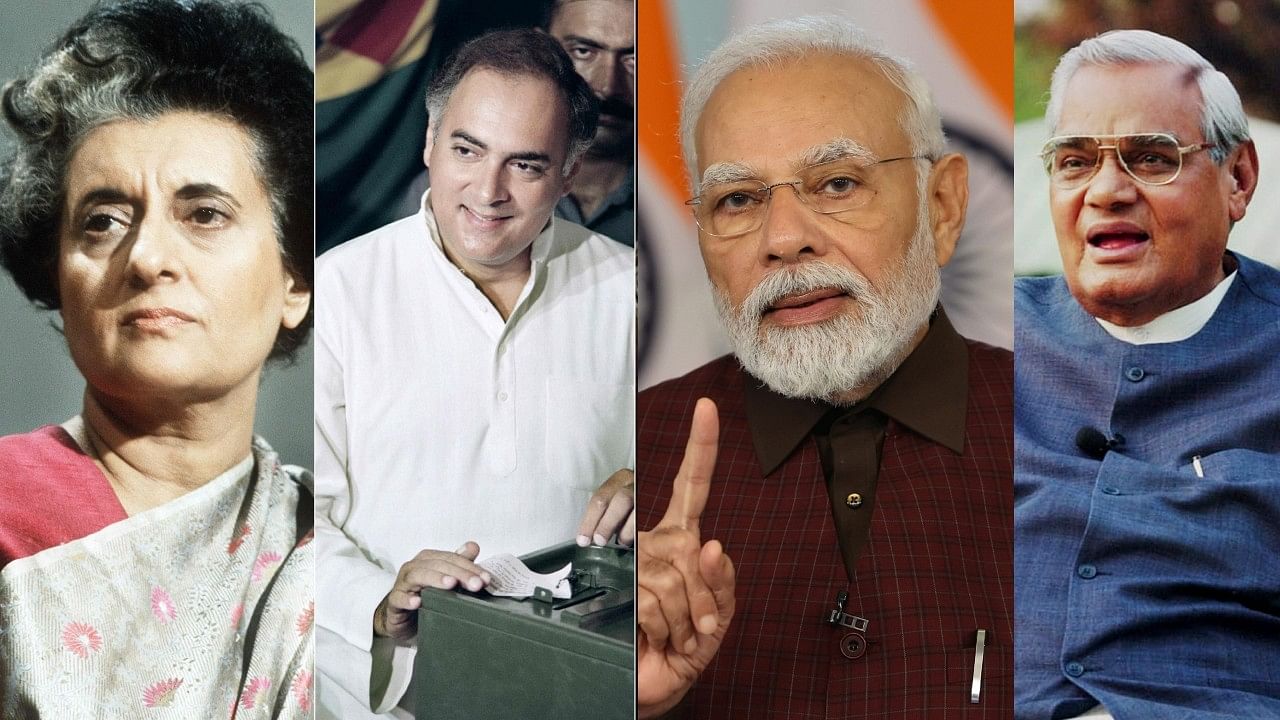
Prime Ministers & their terms of office.
Credit: Special Arrangement
Jawaharlal Nehru (1947-1964): Nehru was the first Prime Minister of India and played a crucial role in shaping modern India and establishing a democratic and secular state.
Credit: DH Pool Photo
Indira Gandhi (1966-1977, 1980-1984): The first and, to date, the only female Prime Minister of India.
Indira Gandhi is known for her centralizing policies and efforts to reduce poverty.
Credit: DH Pool Photo
Manmohan Singh (2004-2014): After serving key positions in finance ministry for decades, Manmohan Singh served as the prime minister from 2004 to 2014. He is known for liberalisation policies of Indian economy, and he's government initiated major social programs like the MGNREGA, and the nation saw economic growth under his tenure.
Credit: PTI
Narendra Modi (2014-Present): Narendra Modi emerged as one of the most influential and powerful prime minister in India. Under his tenure the nation saw immense growth as he brought several reforms focusing on economic reforms, digitalisation of public infrastructure, and multi-modal infrastructural development. His government has also implemented significant policies like GST, and the abrogation of Article 370.
Credit: PTI
Atal Bihari Vajpayee (1996, 1998-2004): AB Vajpayee served twice as Prime Minister of India, first from 16 May to 1 June 1996, and then from 19 March 1998 to 22 May 2004. His tenure saw nuclear tests in 1998, the Kargil War, and significant infrastructure projects like the Golden Quadrilateral.
Credit: PTI
Rajiv Gandhi (1984-1989): After taking Prime Minister's position, Rajiv Gandhi modernised India’s telecom sector and promoted technology.
Credit: DH Pool Photo
PV Narasimha Rao (1991-1996): Narasimha Rao is often credited with liberalising the Indian economy and initiating major economic reforms that transformed the economy of India. He served as India's prime minister for 4 years and 330 days.
Credit: PTI
Morarji Desai (1977-1979): Morarji Desai led the first non-Congress government and worked on promoting transparency and fighting corruption.
Credit: DH Pool Photo
Lal Bahadur Shastri (1964-1966): Shastri served as the second prime minister of India from 1964 to 1966. He promoted the White Revolution and coined the slogan "Jai Jawan Jai Kisan." His tenure also witnessed Indo-Pakistan War of 1965.
Credit: DH Pool Photo
Vishwanath Pratap Singh (1989-1990): VP Singh work towards the upliftment of OBCs and implemented the Mandal Commission recommendations, increasing reservations for OBCs.
Credit: Special Arrangement
HD Deve Gowda (1996-1997): HD Gowda served as the 11th prime minister of India from 1 June 1996 to 21 April 1997. He focused on agrarian issues and rural development during his short tenure.
Credit: DH Pool Photo
IK Gujral (1997-1998): IK Gujral served as India's Prime Minister from 1997 to 1998. He is famous for the Gujral Doctrine in foreign policy, emphasising good relations with neighboring countries.
Credit: X/@MahilaCongress
Chandra Shekhar (1990-1991): Chandra Shekhar faced significant economic challenges during his term. He held the position for a mere 223 days.
Credit: Special Arrangement
Charan Singh (1979-1980): Charan Singh focused on agricultural and rural development but his government fell before he could implement major policies. He served as the Prime Minister of India for 170 days.
Credit: PTI